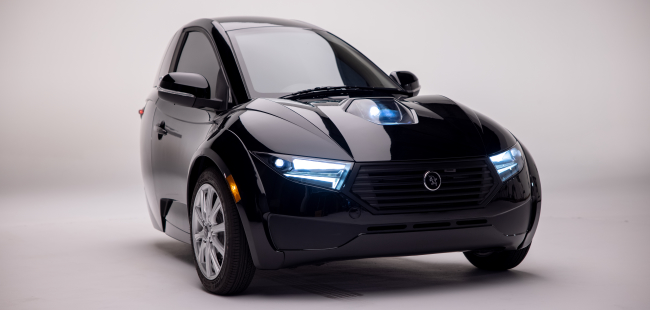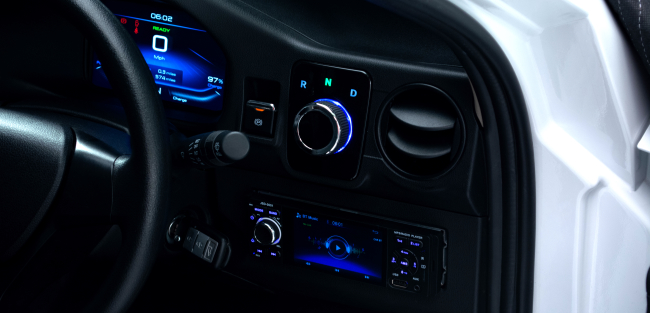
The Commuter EV
Mike McLeod
General AutomotiveElectraMeccanica’s entry-level, three-wheeled SOLO looks to ride wave of enthusiasm for zero emission vehicles.

The single seat, three-wheeled SOLO electric vehicle by Vancouver-based ElectraMeccanica (Photo credit: ElectraMeccanica)
In part, the industry didn’t embark on that transformative journey on its own. Between 2017 and 2019, nearly all industrialized nations, including the EU, China, Canada and many U.S. states, decreed, by one measure or another, that the standard ICE will have seen it’s day by 2050 if not sooner. Couple that with Tesla becoming world’s highest valued car company in 2020, and it’s clear there isn’t only investor enthusiasm for the EV, but market forces pushing toward that transition.
Amid this environment has emerged the SOLO, an entry-level electric vehicle designed and manufactured by Vancouver-based ElectraMeccanica. The distinctive 3-wheeled BEV had its official U.S. launch in late 2020, and, for now, the company says sales will focus on the western U.S. In place of traditional dealerships, the company has followed Tesla’s sales model, with 20 sales kiosks spread across five states including Arizona, Washington, Oregon, Colorado and throughout California.
To eventually supply those orders, ElectraMeccanica broke ground in May 2021 on a 250,000-sq.-ft. manufacturing facility in Mesa, Arizona that the company says will produce 20,000 SOLOs per year. In the meantime, the company has contracted Chinese motorcycle manufacturer, Zongshen Industrial Group, to satisfy the pre-orders the company says it had received prior to launch.
While that might seem an odd choice, the SOLO is technically an enclosed motorcycle, although in most jurisdictions it can operated without a special license. It’s also includes safety features found in a conventional car, including a torque limiting traction control system, front and rear crumple zones, a rollover bar and reinforcement bars in the doors.
That said, the motorcycle classification does exempt the SOLO from meeting NHTSA crash standards, although ElectraMeccanica says the vehicle does meet all Federal Motor Vehicle Safety Standards (FMVSS) standards, as they pertain to motorcycles.
All in all, it would be easy to dismiss the SOLO, at first glance. Despite it’s modern features (e.g. backup camera, heated seats, keyless entry), the EV has room for only a driver and, relative to other EVs, it has a short 100 mile (160 km) in-city range. However, for ElectraMeccanica CEO, Paul Rivera, those stats encapsulate the whole point of the SOLO.
“For all the time that we spend in traffic going to and from work, people in North America commute 16 miles on average and we like to do it by ourselves,” says Rivera, who’s spent 20 years in the alternative fuels and transportation industry before joining ElectraMeccanica in 2019. “So we are often using an over-utilized, over-powered powertrain.”
In place of that high horsepower engine, the SOLO’s belt-driven rear-wheel is powered a liquid cooled 53-hp synchronous AC motor that produces 94 ft-lbs. of torque, a top speed of 80 mph and a 10-second 0-60 mph.
However, focusing on the SOLO’s performance or unique appearance overlooks what makes it very different from most EVs. At a retail price of US$18,500, the SOLO costs approximately a third of the average EV (US$55,600), according to Kelly Blue Book publisher, Cox Automotive.

With a 100-mile (160km) range and US$18,500 sticker price, the SOLO is designed for urban commuters, as well as ride sharing services and fleet applications. (Photo credit: ElectraMeccanica)
And looking at the field, even the cheapest brand-name EVs available in North America carry a comparatively hefty price tag. The four-seat 2021 Mini Electric, for example, is limited to roughly the same range as the SOLO (110 miles) but retails for US$11,400 more (US$29,900).
Other entry-level competitors include the second generation 2021 Nissan Leaf and 2022 Chevy Bolt. For around US$32,000, the stripped down version of 2021 Leaf has only a 150 mile range but offers four-seats/wheels, more amenities and is produced by an established brand. Similarly, GM anticipates its entry-level 2022 Chevy Bolt come in with the same price and amenities as the Leaf, but a range of 259 miles.
For the SOLO to stay in the running, maintaining it’s lower price point is paramount. That fact also helps explain the reasoning behind many of the vehicle’s distinctive design choices. On one level, cutting out the passenger and back seats, plus a back wheel, reduces material and manufacturing costs but also helps reduce the SOLO’s curb weight to less than 1,800 pounds.
Added to weight reduction, having one less wheel reduces the vehicle’s rolling resistance, while the single seat allows for body styling that improves the vehicle’s overall drag coefficient and lowers center of gravity.
Taken together, these factors help the SOLO achieve its 100 miles range using a smaller, lighter and less costly 17.3-kWh lithium-ion battery pack. Although the average cost of an EV battery has declined by 87% since 2010, according to BloombergNEF, it’s still an EV’s most costly component – approximately $156 per kilowatt hour on average.
“The SOLO’s battery is a bit unique because it’s 144 volts, or 72 volts in each door sill. For our needs, this particular cell configuration just worked out well for what we were trying to achieve,” Rivera says. “But over the next 24 to 36 months, as we evolved the vehicle for the global market, that’ll bring changes that include a slightly longer wheelbase, probably front-wheel drive, additional safety features and a different battery pack and cell chemistry.”
In the meantime, Rivera says the North American consumer market represents only a part of the SOLO’s current market potential. In addition to commuters, he says the SOLO is well suited to ride sharing services and the fleet market. The SOLO can be configured with a 5-cubic-foot cargo box with up to a 60 lbs. payload.
“Every one of our vehicles has sophisticated telematics on it so we know location, state of charge, g-forces, acceleration, etc but with consideration of the privacy laws,” he says. “The fact that we have that capability is important for what we want to do on the fleet side.”
“Think about all the different applications that there are when you take off the hatchback and you add the cargo box…for pizza, fast food, grocery delivery, as well as security companies that patrol communities,” he continues, adding that the company has received 1,800 fleet leads since January 2021. “Our vehicle is perfect for that.”
Beyond it’s plans for the SOLO, Rivera says the company’s next major steps will include building on the recent launch of the eRoadster, an electrified version of Intermeccanica’s Porsche 356 replica. Ultimately, Rivera says the company will introduce its high performance Tofino sports car, a modern take on the classic open-top coup.
“We have done a lot through nimbleness, remaining asset light, prudence and with very little capital to get to where are, where we’re able to put a vehicle on the road,” Rivera says. “And we’re just beginning. I’m really excited we’re headed from here.”
www.electrameccanica.com
For the full interview with Paul Rivera, check out the Design Engineering podcast.
